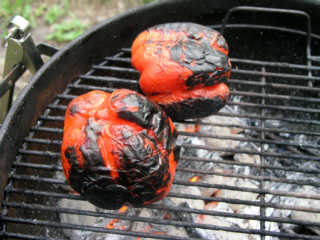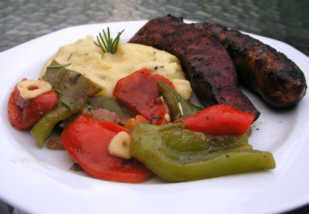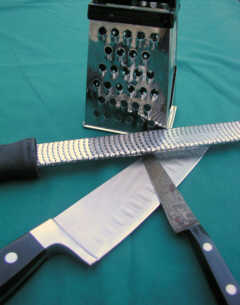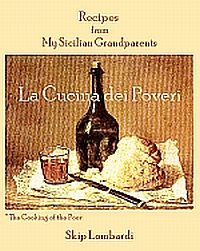Living on $42.00 per Week-Day 6
July 21st, 2007Total food stamp funds remaining: $17.87.
Lunch Friday:
Another pattern emerging from our experiment is that one day’s lunch is often based on leftovers from the previous night’s supper. We don’t see this as a bad thing. It’s a legitimate way to extend the grocery budget, reduce labor, and get a nourishing meal at noontime. And if the original meal was good, we don’t consider leftovers hardship fare.
With the beaten eggs and the halibut collagen, last night’s avogolemono soup was sufficiently rich that we were very satisfied with one bowl, and a smaller second helping. That left us with nearly three cups of soup available for lunch today. And though we didn’t mention it yesterday, we now have 1 1/2 quarts of fish stock in our freezer as well.
Today, for variety, we added nearly 1/4 Lb. of linguine from our miscellaneous, won’t-quite-serve-two pasta inventory. We broke the raw pasta into 1-inch bits and simmered it in the leftover soup till it was al dente. Avogolemono bonds with starch, so a soup can be thickened by adding potatoes, rice, or pasta. With our linguine-thickened avogolemono, we had yet another ample lunch.
Supper Friday:
It was hot, but not unreasonably so, and a great evening for grilling. At our local Sweetbay grocery store, we found a 20 oz. package of 5 Hot Italian sausages for $3.49. We’ve been fans of Sweetbay’s sausages since we first tried them. One of us spent 25 years living in the North End of Boston (THE Italian section where there’s an Italian butcher on nearly every corner). We like Sweetbay’s sausages better than any we ate there.
Sweetbay has a central corporate kitchen in Tampa which supplies all their stores in Florida. We have six Sweetbays in metropolitan Sarasota alone; all sell great sausages. We like to think about a Tuscan nonno—an Italian grandfather—coming into the corporate kitchens as a consultant on sausage-making days:” No, un po più di finnocchio; più peperoncino!” a little more fennel; more hot pepper, he says as workers pour pounds of ground pork and seasonings into a huge mixer. At a certain point in the process, he carefully sautés a small portion of the stuffing, takes a practiced taste, and pronounces, “Ah, salsiccia buona.” And they’re done.
The nonno may be there, he may not, but Sweetbay’s sausages stand out among the best.
We noticed one of the Sweetbay butchers hunched over his work table, knife flashing from time to time. We inquired about what he was carving and he replied, “Beef heart, $1.49 per pound.” This struck us as a superb bargain, and suddenly we were thinking about a Tuscan mixed grill for supper.
Beef heart is a member of that class of meats euphemistically known as “variety cuts,” or offal. Marinated, grilled on a skewer, and called anticucho, it’s a very popular street food in Peru. Apparently we have enough Peruvians and other beef heart-eaters to give Sarasota criticial mass, and thus make it worthwhile for supermarkets to keep it in stock. At $1.49 per pound, it’s a very inexpensive way to get high quality protein that does not require a lot of preparation.
Ferreting around in a cabinet beneath the kitchen counter, we found a bag of harina de mais fina amarilla, fine yellow corn meal we had bought a while ago at a Latino market. It turns out that this corn meal makes superb polenta. (Imported Italian corn meal for polenta runs about $3 for a 17.5 oz. package. We got 16 oz.of Mexican harina for 69 cents.)
And since we were going to have the grill going for the meats, we thought it would be a fine time to roast some of the bell peppers we’d bought earlier this week at the Red Barn. (We are fuel-frugal, too.)
This was shaping up to be a glorious, trattoria-style feast. Only the beef required any degree of prep work: we marinated four slices (about 8 oz.) in a mixture of red grapfruit juice (While foraging, one of us had scored a fallen, late-harvest grapefruit on a neighbor’s lawn earlier in the afternoon). Our marinade was simple: the grapefruit juice with just a splash of olive oil, sliced garlic, ground black pepper, and fresh rosemary (we have a veritable rosemary “shrub” growing in our front yard).
We’ve written before about grilling over palmetto and using the woody stalks of the palm fronds. Since we live in a neighborhood checkered with palm trees, finding this aromatic fuel for our domed Webber grill (another trash day street-find) is never a problem. Palmetto burns much hotter than charcoal, but the fire doesn’t last as long, so we supplement our fires with ten to twelve lumps of hardwood charcoal. Nevertheless, palmetto smoke imparts a delicious and distinctively Floridian flavor to meats.

We put the peppers on the fire before it really settled down to embers, because we wanted to get a good char on the skins for easy peeling.
When they were done, we took them off the grill, redistributed the coals and added more palmetto before putting on the sausages and beef heart.
Total food stamp funds remaining: $17.87 – 5.20 = $12.67
Now is as good a time as any to remind ourselves that to fully satisfy, food should please the eye as well as the palate. If you take the time to cook, don’t eat dinner in front of the TV or standing over the kitchen sink. Take the time to plate your creations, then sit down at the table to savor rewards well earned.

Links to the other posts in our series:
Living on $42.00 Per Week—the Challenge
Living on $42.00 Per Week—Day 1
Living on $42.00 Per Week—Day 2
Living on $42.00 Per Week—Day 3
Living on $42.00 Per Week—Day 4
Living on $42.00 Per Week—Day 5
Living on $42.00 Per Week—Day 7
Living on $42.00 Per Week—Summary
Living on $42.00 Per Week—Redux
Living on $42.00 per Week-Day 5
July 20th, 2007Lunch Thursday:
Lunch today was catch-as-catch-can. One of us had a dental appointment that caused involuntary facial contortions from Novocaine, and the other had mid-day business in Lakewood Ranch.
When we finally came together for a meal, it was nearly 3:00 p.m., and we were (metaphorically) “famished.” Knowing that this is when we or anyone is most likely to succumb to indiscriminate snacking, we did not simply plunge into the larder in search of instant gratification. Instead, we made a simple salad of 1/2 an avocado, a plum tomato, chopped Italian parsley, the grated rind & juice from half a lime, a squirt of hot sauce, and 2 tablespoons of sunflower seeds. (We buy ours in bulk, dry-roast them in the toaster oven and keep them on hand for occasions like this.) We had our salad with a two heated rounds of whole wheat pita bread. We took no more than 10 minutes to prepare everything, and there was just enough food to take the edge off until supper. Furthermore, we had a chance to sit down, talk, and relax a bit in the midst of a very busy day.
Kitchen tools: (Williams-Sonoma will hate us)

We began this project with a toolkit: Interest, enthusiasm, experience, appetites, and skills. But we couldn’t have implemented much of what we’ve done without tangible tools. For years, we’ve been reading about “the one kitchen tool” some rock star chef “can’t live without.” In our case, we can’t identify just one, but here, in no order of priority, are four inexpensive tools we feel every kitchen should have.
A Box Grater. We admire Mario Batali for his ability to create a snow-shower of Parmigiano with his Microplane grater. We question how much of the cheese finds its way onto the food, but it looks spectacular on TV. For most of our basic grating needs though, we rely this old standby.
A Chef’s Knife. We’ve read and heard all the hype about Wusthof, Henkel, Global, and recently, Kyocera. But for us, our knives (with or without pedigree) must be comfortable to be useful. And any knife can be sharpened. We found our Sabatier Santoku knife at T.J. Maxx for $9.95. It’s the bargain end of the Sabatier line but it feels good. However, before we brought it home, we took it to our local True Value hardware store and had it professionlly sharpened for $4.00. Now we have a tool that’s a pleasure to use in the kitchen. We simply give it a few swipes with a sharpening steel and make short work of whatever we chop or slice.
A Paring Knife. Ours is so old, we’re no longer sure where we bought it. But it, too, is French. Made from carbon steel, it has been professionally sharpened as well. It’s an invaluable instrument for the finer jobs we do in the kitchen, like dissecting meat from fish frames.
A Microplane Grater. At approximately $12.00, some might perceive this as a luxury. Beyond its obvious use for grating hard cheeses, this is sine qua non for grating citrus rind, fresh ginger, and carrots. We’ve even used it for making extra-fine bread crumbs. With the capabilities it’s given us, it has paid for itself many times over.
Supper Thursday:
After our ceviche meal, we banked our greatest bargain: we froze the Whole Foods halibut frame until we could afford it the time and thought it deserved. The Novocaine had worn off and one of us was still feeling a little sore, so a hearty soup seemed a good choice for supper. Cue in the fish frame…
In a large pot, we barely covered the fish frame with 10-12 cups of water. At this stage, our only seasonings were two bay leaves and about twenty black peppercorns. We brought the pot to a simmer; the broth began to perfume the kitchen. And we really mean that. There’s a reason professional cooks hold pricey halibut in such high esteem. Our broth was not fishy, but fresh—like an evening at the beach. As the broth hovered around a simmer, we began to gently scrape at the bones to release whatever meat still remained on the frame.
We’d planned to add some pieces of inexpensive frozen ocean perch ($3.49 for a 1 lb. bag at Sav-A-Lot, and we did have some in our freezer). However, we’d already gleaned more than a cup of halibut from the frame. The wafting stockpot aroma was so pure that we began to say things like, “You know, we may not need to add any more fish or seasonings…” But we did put one whole carrot into the stock, which we removed and reserved later, while it was still intact.
After about an hour, we strained the stock into another pot and picked as much of the meat as we could from the cooked bones. When we were done, we definitely had enough halibut meat for two.
But then, being foodies, we faced a dilemma: we wanted a simple preparation that would not obscure the halibut flavor. We had thought briefly about cotriade, a very simple fish soup from Brittany, and we had considered a minimalist version of soupe de poisson, the classic Provençal fish stew, which would have demanded olive oil, tomatoes, a bouquet of herbs, and saffron (all of which we had within reach). But to best illustrate frugality with flair, we chose the classic Mediterranean egg and lemon soup frequently known by its Greek name, avogolemono. The mixture can also be a sauce—enhancing poultry, meat, fish, and vegetarian dishes throughout the Eastern Mediterranean. It’s a great way to stretch a couple of eggs and a single lemon.
Four small, red-skinned potatoes, cut into bite-sized pieces and 4 cloves of chopped garlic went into the strained, simmering stock.
Into a separate bowl, we grated the rind of one lemon, then added its juice. We scrambled two large eggs and the juice until they were well-combined, beginning to froth. We couldn’t pour this mixture directly into the stock, or we’d have fish stock with scrambled eggs. So we took a ladle of stock, poured it into the eggs-with-lemon and fork-stirred to blend and bind the mixture—to “temper” the eggs. After adding two more ladles of hot liquid, we stirred the egg and lemon mixture into the stock. Having checked to be sure the potatoes were tender, we sliced the reserved carrot and added it to the broth. After tasting for salt, we were done.
A little finely chopped parsley for garnish, two ciabatta rolls, and we had one of our most elegant suppers yet.
Links to the other posts in our series:
Living on $42.00 Per Week—the Challenge
Living on $42.00 Per Week—Day 1
Living on $42.00 Per Week—Day 2
Living on $42.00 Per Week—Day 3
Living on $42.00 Per Week—Day 4
Living on $42.00 Per Week—Day 6
Living on $42.00 Per Week—Day 7
Living on $42.00 Per Week—Summary
Living on $42.00 Per Week—Redux
Living on $42.00 per Week-Day 4
July 19th, 2007Total food stamp funds remaining: $17.87.
Lunch Wednesday:

After yielding two meals, our weekend chicken didn’t owe us a thing. Nonetheless, we took the remaining bones (approx.. 6 oz. including the bits of meat clinging to them) and made our version of “stone soup *.”
Placing the bones in a 3-quart sauce pan with approx. 3 cups of water, we simmered them for 15 minutes then strained the liquid, reserving the bones. When the bones were cool enough to handle, we stripped them of their meat. Suprisingly, we had nearly 3/4 of a cup.
We brought the chicken broth back to a boil and added 1/4 cup of medium-grain white rice, some minced ginger root, garlic, and 2 kaffir lime leaves **. Having reduced the heat, we let the covered pot simmer for 15 min., until the rice was done.
Sunday’s pre-cooked carrots were thinly sliced and put into the pot along with a rib of celery and a scallion (both minced). In the spirit of “Archeology begins at home. Excavate your own fridge first,” we also tossed in half-moon slices from a piece of daikon found lurking on the bottom of the vegetable bin.
A dash of hot sauce, salt & freshly ground pepper, and a few snips of flat-leaf Italian parsley (because we’d forgotten to buy cilantro) finished this lively, vaguely Thai-tasting soup. It gave us 2 servings each.
Stone Soup provides a great illustration of how we—and anyone else—can make a tight food budget work. Leftovers aside, imagination and a little effort are the crucial ingredients in any satisfying dish.

This meal marked the last of our day-old rolls from BJ’s. They’ve served us well. And with our little trick with the kitchen faucet and the toaster oven, they’ve provided a satisfying accompaniment to many of the casual meals we’ve been enjoying this week. And at $2.00 for eighteen rolls, they rank along side our produce supply as one of the best bargains we’ve found for this experiment.
* Stone Soup: The old parable of how those with little, gain much if they share what they do have.
** This may seem a bit over-the-top on a food-stamp budget, but we’ll explain: we’d bought the kaffir lime leaves from our local Vietnamese grocer before Christmas last year. For $1.00 we came home with a bag containing approximately 70 of these beauties. They keep well in the freezer, and we’ve simply been dipping into the bag as recipes warrant. Though we also have lemon grass growing in our back yard, we decided against using it for this recipe in the interest of time and simplicity.
Supper Wednesday:
Midway through our challenge, the Sicilian half of this duo was suffering from pasta withdrawl. What better way to assuage the malady than to use up 3/4 cup of ricotta left from last week? Because we also had some Red Barn eggplant, and because it was already after 8 PM, and because we often turn to other sources for inspiration, we Googled “ricotta + eggplant + pasta” and found ourselves on the Food & Wine website. A recipe for pasta with eggplant, ricotta, and tomatoes was right there. Did we follow it? Not really, but sometimes all one needs is an idea.
Eggplants have earned a bad reputation for being oil sponges. Cooks of all stripes have long tried to devise techniques to keep their eggplants from absorbing all that precious olive oil. Among alternatives to frying is merely brushing eggplant slices with oil and either baking them or putting them under the oven broiler.
We have two oil-free techniques, each of which flies in the face of centuries of Italian cookery. One, is to use our George Foreman outdoor grill. It gets just hot enough to cook the eggplant slices through without burning them. We can season them later when we assemble a dish like eggplant parmigiana or mousakka
The other prep method is more radical, more counter-Italian than even an electric grill: we steam our eggplant. This requires total attention, because eggplant can quickly go from firm to mushy. But steaming uses no oil and takes approximately 3 minutes.
If steaming eggplant is radical, our method for cooking pasta will send Italians, Italophiles, and foodies in general into paroxysms. Depending on the recipe, whenever we can, we use our trusty Pasta Perfect, *** as seen on TV. (That’s according to the blurbs on the box. We don’t have cable; for that matter, we don’t even own a TV.)
Before moving to Sarasota, we bought our Pasta Perfect as a joke at one of those “job lot” stores in Connecticut. However, it turned out the joke was on us. It works…mostly. We can cook spaghetti or linguine to the al dente state. But certain shaped pastas—like penne, rigatoni, or shells—will cook only so far and no further, no matter how long they sit in steaming water. That’s okay because the only time we use Pasta Perfect is when we plan to finish cooking our pasta in a sauce.
But the benefits of our Pasta Perfect outweigh the laughs. We need boil only two quarts of water rather than six; once the water comes to a boil, we can turn off the stove, saving energy. We don’t need a colander because the top of our Pasta Perfect is perforated for easy drainage. Finally, when we’re done, clean-up is not a pot and a colander, but just the single plastic tube of Pasta Perfect.
Alas, delicious as this recipe may be, it turned out to be brutta ma buona, that is, not particularly photogenic.
Pasta with Eggplant & Ricotta
Ingredients:
1 Small eggplant, approximately 1/2 Lb., cut into 3/4 in. cubes
Olive Oil
2 Cloves garlic, sliced
1 Small onion, diced
1 tsp. Crushed red pepper flakes
4 – 5 Plum tomatoes, coarsely chopped
3/4 Cup whole milk ricotta
1/4 Cup flat-leaf Italian parsley, finely chopped
Salt & freshly ground black pepper
Parmigiano cheese
1/2 Lb. Short, tubular pasta (We used campanelle. Substitute penne, rigatoni, or mostaccioli if you prefer)
Preparation:
Bring about 1 in. of water to a boil in a three-quart saucepan. Add 1 Tbs. salt, then the eggplant. Reduce heat to medium-low and steam the eggplant for approximately three minutes, or until it’s slightly translucent and tender. Drain in a colander and reserve.
Heat a large saute pan over medium-high heat. Add just enough olive oil to film the bottom of the pan, then add the garlic, onion and red pepper flakes. Lower the heat slightly, and saute the mixture until the onion is wilted; three or four minutes.
Add the tomatoes, and cook until they soften and begin to render some of their juices. Add the eggplant, and cook to heat through. Taste for seasoning and add salt & pepper as necessary.
Reduce heat to low, and stir in the ricotta. Maintain on low heat while the pasta cooks.
Cook the pasta in your traditional way, according to the manufacturer’s recommendations. When the pasta is al dente, drain and add it with the parsley to the sauce. Raise the heat slightly and cook, stirring gently to keep it from sticking, for two or three minutes until the pasta is done, and has absorbed some of the sauce.
Pour the pasta into a large bowl, garnish with freshly grated Parmigiano, and serve family-style.
Ordinarily, this would be sufficient for four as a pasta course. Since it was our whole dinner, this served two abundantly.
*** We agree, Pasta Perfect is so strange, it deserves a blog post of its own. We’ll put that on our to-do list for the future when we’ve finished writing about our Food Stamp Challenge experiences.
Links to the other posts in our series:
Living on $42.00 Per Week—the Challenge
Living on $42.00 Per Week—Day 1
Living on $42.00 Per Week—Day 2
Living on $42.00 Per Week—Day 3
Living on $42.00 Per Week—Day 5
Living on $42.00 Per Week—Day 6
Living on $42.00 Per Week—Day 7
Living on $42.00 Per Week—Summary
Living on $42.00 Per Week—Redux
Living on $42.00 per Week-Day 3
July 18th, 2007Total food stamp funds remaining: $17.87.
Lunch Tuesday:
Last night’s supper became the basis for lunch today: we supplemented the leftover chunks of potato salad, tomato slices , and about half a cup of ceviche with an additional boiled potato, five leaves of torn Romaine, and one more tomato to yield a lunch-sized salad for two. The marinades, juices, and herbs from the three dishes were almost adequate as a dressing, but we added a little more vinegar and another spoonful of olive oil. Along with the salad, we had some of our day-old BJ’s rolls.
At this point, our rolls are becoming a little long in the tooth, but we know a trick to revive them: we simply pass them quickly under running water, shake them off and toss them into the toaster-oven at approximately 375 F. for five to ten minutes. Voila!! nearly fresh rolls.
As we go along with this experiment, we’re seeing a theme emerge: maintaining a reasonable diet on such a limited budget requires significant thought and planning. And we admit it—we have another advantage: we truly enjoy the process. For example, on Sunday, while cooking potatoes for our dinner salad, we added a few extras, just to have them available as ready-to-use components of other dishes later in the week. So it was easy today to augment leftovers from last night with another potato.
We also had carrots in the fridge before we started. We par-cooked two of them for three minutes with the potatoes even though we had no specific use in mind. Now, they’re available when we make a quick soup or perhaps for a carrot salad.
Our endeavors have not been limited to shopping and cooking. We’ve also been at our desks—reviewing other blogs and news sources concerning the “Food Stamp Challenge.” As part of an organized program (May 15-21, 2007), several members of Congress and numerous bloggers across the country attempted to survive on the weekly allotment of $21.00*.
We have observed something noteworthy: many of the participants didn’t cook. They simply went to the grocery store and bought the cheapest food they could find. It’s laudable that many of them bought apples, bananas, salad ingredients, and canned tuna fish, but there seemed to be no underlying strategies, and they found that they quickly depleted their weekly allowance. We said at the outset we had an edge as foodies who know how to cook. And unless you live in an area with markets that sell low-cost vegetables, following our program would be an even bigger challenge. We feel that to make the experiment work, and for that matter to make food stamps work in the real world, one must cook, or be part of a household or social group where someone else cooks—from scratch.
Of course $21.00 per week for food is Spartan by any American’s definition. But we’re not so married to our liberal ideals that we think increasing the weekly allowance is the whole answer (although it’s a good start). In order to succeed, no matter how large the budget, we feel that part of the food stamp program should involve some kind of education. At a minimum, the program needs an instructional component that shows food stamp recipients how to select, prepare, and store fresh food. Bilingual pamphlets won’t do it—we mean instruction: free classes, demos in schools, DVDs, TV—anything to show people how to make appealing and healthy food on a shoestring. Oprah and Cristina, are you listening?
We feel, for example, that those bags of pre-washed, pre-cut lettuces are among the worst ways to use our food budget (sorry, Rachael Ray.) At mainstream grocery stores here in Sarasota, a bag of pre-washed lettuce would deplete an individual’s weekly food stamp budget by nearly 20%. On the other hand, a head of Romaine—even if it is slightly wilted—costs $1.00 at the open produce market. We revive it by simply cutting a small piece from the base and standing the head upright in an inch or so of water, (in a recycled yogurt container). We place the lettuce on the shelf of the fridge door, like a bouquet (We use the same trick to keep our parsley from wilting.)
We think it is legitimate to ask: do most people with food insecurities own salad-spinners or know how to wash greens and then, know how to store them? And we’ve not even arrived at the point of food preparation! A lot of people don’t know how to dress a salad with oil and vinegar, how to sweat collards, or how to stir-fry sliced zucchini.
Supper Tuesday:
Once again, we brought out our Wal*Mart rotisserie chicken, divided the remains in two, so we each had a serving of breast meat and a wing (a less elegant version of the “Statler breast”). We simmered two of our sweet potatoes till tender, slipped off their skins, and mashed them with garlic, a little salt, and coarsely chopped parsley. An apple found in the fridge became a fresh chutney with green bell pepper, ginger root, lime rind, lime juice, and a dash of chili sauce.
* The weekly food stamp allowance varies from state to state—on the Web we’ve found allotments ranging from $19 to over $24 per week. $21 is our Florida figure.
Links to the rest of the posts in our series:
Living on $42.00 Per Week—the Challenge
Living on $42.00 Per Week—Day 1
Living on $42.00 Per Week—Day 2
Living on $42.00 Per Week—Day 4
Living on $42.00 Per Week—Day 5
Living on $42.00 Per Week—Day 6
Living on $42.00 Per Week—Day 7
Living on $42.00 Per Week—Summary
Living on $42.00 Per Week—Redux



